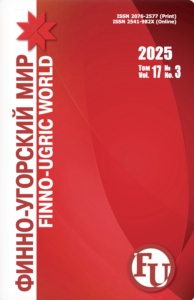Mosina Natal’ia M.,
Doctor of Philology, Professor, Department of Finno-Ugric and Comparative Linguistics, Ogarev Mordovia State University (Saransk, Russia), natamish@rambler.ru
Kazaeva Nina V.,
Candidate Sc. {Philology}, Associate Professor, Department of Finno-Ugric and Comparative Linguistics, Ogarev Mordovia State University (Saransk, Russia), nikazaeva@yandex.ru
Introduction. Somatic vocabulary, belonging to the oldest layer of lexical language, has long been the focus of linguists. Somatic tokens occupy a special place in the phraseological foundation of many languages. Research shows that most common somatisms are the names of the outer parts of the human body. The relevance of this topic is due to the fact that phraseological units with a somatic component is a large group of phraseological units in the Hungarian, Finnish and Moksha languages, which requires additional study. The object of the study is a comparative analysis of phraseological units in these languages, taking into account their semantic characteristics. The subject of the study is phraseological units with the somatic component fej / pää / пря ‘head’. The purpose of the study is to identify common semantic regularities in the phraseological foundation of the named distant Finno-Ugric languages, the definition of full or partial equivalents and equivalents of phraseological units.
Materials and Methods. The material of the study was the phraseology with the somatic component fej / pää / пря ‘head’, selected by us using the method of continuous sampling from the phraseological and bilingual dictionaries of the Finnish, Hungarian and Mokshan languages. The study involves comparative, comparative and descriptive methods of analysis.
Results and Discussion. The phraseological units selected by us in the studied languages with somatic meaning “head” could be classified according to the principle of the semantic characteristic into four groups: 1) cognitive activity; 2) a person’s mental abilities; 3) physical and mental condition; 4) behavior.
Conclusion. Somatic phraseological units with the component fej / pää / пря ‘head’ in the Hungarian, Finnish and Moksha languages express different meanings that coincide in most cases with the studied languages, which allowed them to be combined on the basis of a common semantic feature. Along with this, the prevalence of full and partial equivalents has been established; the presence of separate non-equivalent phraseological units in the languages represented shows the national and cultural identity of the speakers of these languages.
Key words: phraseological units; somatic component; semantics; Hungarian language; Finnish language; Moksha language.
For citation: Mosina NM, Kazaeva NV. Semanticheskaia kharakteristika i osobennosti frazeologicheskikh iedinits s komponentom-somatizmom fej / pää / пря ‘golova’ v vengerskom, finskom i mokshanskom iazykakh [Semantic characteristics and features of phraseological units with component-somatism fej / pää / пря ‘head’ in the Hungarian, Finnish and Moksha languages]. Finno-ugorskii mir = Finno-Ugric World. 2017; 3: 39–46. (In Russian)
1. Vakk F. O somaticheskoi frazeologii v sovremennom estonskom iazyke: avtoref. dis. … kand. filol. nauk [On somatic phraseology in the modern Estonian language. Abstract of cand. philol. sci. dis.]. Tallinn; 1964. (In Russian)
2. Gircheva OE, Kazaeva NV. Semanticheskaia kharakteristika somaticheskikh frazeologizmov s komponentom kéz ‘ruka’ v vengerskom iazyke [Semantic characteristic of somatic phraseological units with component kéz ‘hand’ in Hungarian]. Ogarev-online. 2015; 2. Avialable from: http://journal.mrsu.ru/arts/semanticheskaya-kharakteristika-somaticheskikh-frazeologizmov-s-komponentom-kez-ruka-v-vengerskom-yazyke (accessed 28.07.2017). (In Russian)
3. Dzhumanova DR. Priemy i osobennosti perevoda frazeologizmov [Methods and features of translation of phraseological units]. Vestnik Moskovskogo gosudarstvennogo lingvisticheskogo universiteta = Bulletin of the Moscow State Linguistic University. 2011; 630: 39–47. (In Russian)
4. Drigalova ED, Mosina NM. Sopostavitel’nyi analiz frazeologicheskikh edinits s somatizmom «pää» / «golova» v finskom i russkom iazykakh [Comparative analysis of phraseological units with somaticism “pää” / “head” in Finnish and Russian languages]. Ogarev-online. 2017; 8. Avialable from: http://journal.mrsu.ru/arts/sopostavitelnyj-analiz-frazeologicheskix-edinic-s-somatizmom-paa-golova-v-finskom-i-russkom-yazykax (accessed 28.07.2017). (In Russian)
5. Kulakova NA, Rogozhina VF. Mokshen’ kialen’ kevonzaf valsiulmon’ valks. Saransk; 2013. (In Moksha)
6. Laver VI, Zikan’ IV, Peshchak MM. Russko-ukrainsko-vengerskii frazeologicheskii slovar’ [Russian-Ukrainian-Hungarian phrase book]. Kiev; Uzhgorod; 1985. (In Russian, Ukrainian and Hungarian)
7. Popov AA. Perezhitki drevnikh doreligioznykh vozzrenii dolganov na prirodu [Remnants of the ancient pre-religious views of dolgans on nature]. Sovetskaia etnografiia = Soviet Ethnography. 1958; 2. (In Russian)
8. Teliia EN. Bol’shoi frazeologicheskii slovar’ russkogo iazyka [Big phraseological dictionary of the Russian language]. Moskva; 2006. (In Russian)
9. Fedorov AV. Osnovy obshchei teorii perevoda [Fundamentals of General Theory of Translation]. Moskva; 1983. (In Russian)
10. Frazeologizmy russkogo iazyka [Phraseological units of the Russian language]. Avialable from: https://orfogrammka.ru/shpargalki/frazeologizmy_russkogo_iazyka/ (accessed 28.07.2017). (In Russian)
11. Frazeologizmy [Phraseological units]. Avialable from: https://ru.wiktionary.org/wiki/kategoriaFrazeologizmy/ru (accessed 28.07.2017). (In Russian)
12. Shirmankina RS. Frazeologicheskii slovar’ mordovskikh (moksha i erzia) iazykov [Phraseological Dictionary of the Mordovia (Moksha and Erzia) language]. Saransk; 1973. (In Moksha and Erzian)
13. Bárdosi V, Kiss G. Szólások. Budapest; 2005. (In Hungarian)
14. Gáldi L. Magyar-оrosz szótár. Budapest; 2000. (In Hungarian and Russian)
15. Gáldi L. Orosz-magyar kéziszótár. Budapest; 1983. (In Russian and Hungarian)
16. Varga J, Saarinen S. Fennizmusok. Finn szólások és kifejezések tára magyarok számára. Turku; 2009. (In Finnish)






















